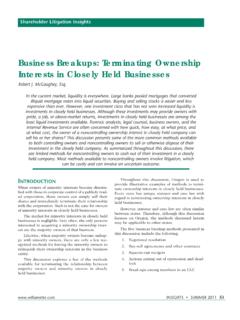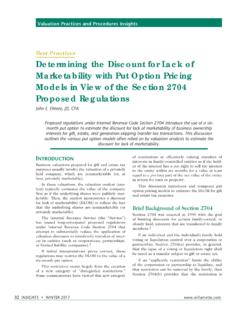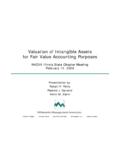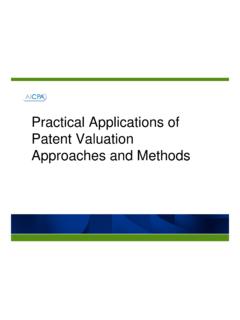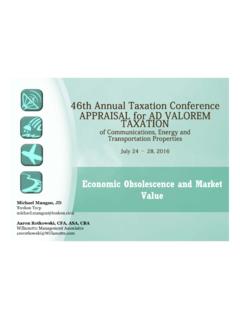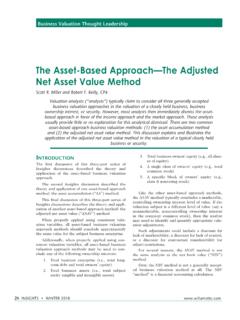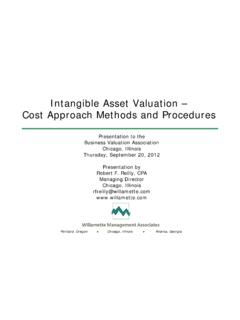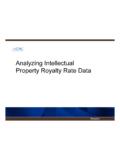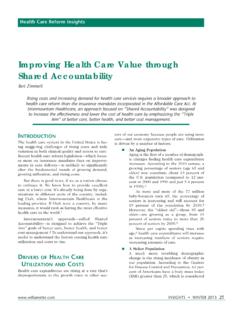Transcription of Accounting Standards Codification Topic
1 Www .willamette .com INSIGHTS SUMMER 2011 29 Accounting Standards Codification Topic 450 and the Valuation of Contingent LiabilitiesJames G. Rabe, CPAF orensic Analysis InsightsThis discussion presents (1) an overview of current and proposed guidance regarding the Accounting for loss contingencies , (2) examples of common methods used by valuation analysts to estimate the value of contingent liabilities, and (3) guidance from three judicial decisions that have considered the valuation of contingent analysts are frequently retained to esti-mate the value of an ownership interest in an entity that is exposed to a loss contingency. A loss contin -gency is defined as an existing condition, situation, or set of circumstances involving uncertainty as to possible loss to an entity that will ultimately be resolved when one or more future events occur or fail to occur.
2 1 Examples of a loss contingency include the fol-lowing:1. Pending or threatened litigation2. Environmental liabilities3. Injury or damage caused by products soldEntity financial statement accounts and foot-notes may contain some of the necessary informa-tion required by valuation analysts to estimate the value of contingent liabilities. Accounting Standards Codification (ASC) 450 presents the existing guid-ance regarding the Accounting for loss an effort to continue the movement toward increased transparency in financial reporting, in July 2010, the Financial Accounting Standards Board (FASB) released a proposed Accounting Standards Update (ASU), Disclosure of Certain Loss contingencies . The proposed ASU would require an increased disclosure regarding certain loss discussion presents:1.
3 A summary of ASC 450, presenting exist-ing professional guidance regarding the Accounting for loss contingencies ;2. a summary of proposed ASU, Disclosure for Certain Loss contingencies , presenting proposed amendments to existing guidance regarding Accounting for loss contingencies ;3. common methods used by valuation ana-lysts to estimate the value of contingent liabilities; and4. insights from three judicial decisions that have considered the valuation of contingent Standards codiFic Ation Topic 450 Existing GuidanceASC 450 requires companies to assess the degree of probability of an unfavorable outcome before reporting a loss to ASC 450, when a loss contingency exists, the likelihood that a future event or events will confirm the loss or impairment of an asset or the incurrence of a liability can range from probable to INSIGHTS SUMMER 2011 www.
4 Willamette .comASC 450 classifies the range of possible losses as probable (the future event or events are likely to occur), reasonably possible (the chance of the future event or events occurring is more than remote but less than likely), and remote (the chance of the future event or events occurring is slight).According to ASC 450, an estimated loss from a loss contingency will be accrued by a charge to income if both of the following conditions are met: 1. Information available before the financial statements are issued or are available to be issued indicates that it is probable that an asset had been impaired or a liability had been incurred at the date of the financial The amount of the loss can be reasonably , ASC 450 requires the accrual of losses when:1.
5 They are probable,2. they can be reasonably estimated, and3. they relate to events or activities of the cur-rent or prior accordance with ASC 450, entities normally disclose the nature of their loss contingencies . However, because of the complexities in reasonably estimating a specific loss figure, entities often do not provide estimates of their loss UpdateOn July 20, 2010, the FASB issued a proposed ASU, Disclosure of Certain Loss contingencies . The FASB s proposal is the culmination of an extended study following its 2008 proposal to amend the stan-dards regarding loss purpose of this ASU was to respond to financial statement users concerns that disclosures about loss contingencies under the existing guid-ance do not provide adequate and timely informa-tion to assess the likelihood, timing, and magnitude of future cash outflows associated with loss amendments in the proposed ASU would establish the following disclosure objective: an enti-ty will disclose qualitative and quantitative informa-tion about loss contingencies to enable financial statement users to understand:1.
6 The nature of the loss contingencies ,2. the potential magnitude of the loss contin - gencies , and3. the potential timing of the loss contingen-cies (if known).PrinciplesAccording to the proposed ASU, to achieve this objective, an entity would consider the following principles in determining disclosures that are appro-priate for its individual facts and circumstances for loss contingencies that meet the disclosure stan-dard:1. During early stages of a loss contingency s life cycle, an entity will disclose informa-tion that is available to enable users to understand the loss contingency s nature, potential magnitude, and potential timing (if known). Available information may be limited and, therefore, disclosure may be less extensive in the early stages of loss contingency.
7 In subsequent reporting periods, disclo-sure will be more extensive as additional information about a potential unfavorable outcome becomes An entity may aggregate disclosures about similar contingencies (for example, by class or type) so that disclosures are understand-able and not too detailed. If an entity pro-vides disclosures on an aggregated basis, it will disclose the basis for ThresholdAccording to the proposed ASU, an entity will disclose information about a contingency if there is at least a reasonable possibility (that is, more than a remote possibility) that a loss may have been incurred regardless of whether the entity has accrued for such a loss (or any portion of that loss). Disclosure is not required of a loss contingency involving an unasserted claim or assessment if there has been no manifestation by a potential claimant of an awareness of a possible claim or assessment unless both of the following conditions are met:1.
8 It is considered probable that a claim will be There is a reasonable possibility that the outcome will be addition, disclosure of asserted but remote loss contingencies may be necessary, due to their nature, potential magnitude, or potential timing (if known) to inform users about the entity s vulner-ability to a potential severe impact (defined as a www .willamette .com INSIGHTS SUMMER 2011 31significant financially disruptive effect on the nor-mal functioning of an entity).Factors that an entity should consider in making this determination include any of the following:1. The potential impact on the entity s opera-tions2. The cost to the entity for defending its con-tentions3. The amount of effort and resources man-agement may have to devote to resolve the contingencyAccording to the proposed ASU, when assessing the materiality of loss contingencies to determine whether disclosure is required, an entity shall not consider the possibility of recoveries from insurance or other indemnification RequirementsThe proposed ASU requires the following qualitative disclosures about loss contingencies that meet the disclosure threshold:1.
9 The entity must disclose qualitative infor-mation to enable users to understand the loss contingency s nature and During early stages of asserted litigation contingencies , the entity must disclose the contentions of the parties (for example, the basis for the claim and the amount of damages claimed by the plaintiff, and the basis for the entity s defense or a statement that the entity has not yet formulated its defense). In subsequent reporting periods, disclo-sure shall be more extensive as additional information about a potential unfavorable outcome becomes available. Furthermore, if known, an entity will disclose the anticipated timing of, or the next steps in, the resolution of individually material asserted litigation For individually material contingencies , disclosures should be detailed enough to enable financial statement users to obtain additional information from publicly avail-able sources such as court When the entity provides disclosure on an aggregated basis, the entity must provide the basis for aggregation and information that would enable financial statement users to understand the nature, potential magni-tude, and potential timing (if known) of the For all contingencies that are at least rea-sonably possible (more than remote), an entity must make the following quantitative disclosures :a.
10 Publicly available quantitative infor-mation for example, in the case of litigation contingencies , the amount claimed by the plaintiff or the amount of damages indicated by the testimony of expert If it can be estimated, the possible loss or range of loss and the amount If the possible loss or range of loss can-not be estimated, a statement that an estimate cannot be made and the rea-sons Other nonprivileged information that would be relevant to financial state-ment users to enable them to under-stand the potential magnitude of the possible Information about possible recoveries from insurance and other sources only if, and to the extent that it has been provided to the plaintiff(s) in a litiga-tion contingency, it is discoverable, or it relates to a recognized receivable for such recoveries.
